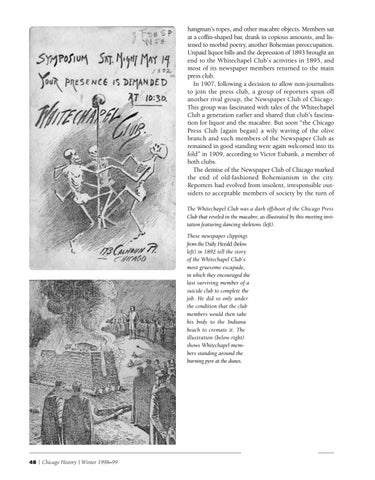hangman’s ropes, and other macabre objects. Members sat at a coffin-shaped bar, drank in copious amounts, and listened to morbid poetry, another Bohemian preoccupation. Unpaid liquor bills and the depression of 1893 brought an end to the Whitechapel Club’s activities in 1895, and most of its newspaper members returned to the main press club. In 1907, following a decision to allow non-journalists to join the press club, a group of reporters spun off another rival group, the Newspaper Club of Chicago. This group was fascinated with tales of the Whitechapel Club a generation earlier and shared that club’s fascination for liquor and the macabre. But soon “the Chicago Press Club [again began] a wily waving of the olive branch and such members of the Newspaper Club as remained in good standing were again welcomed into its fold” in 1909, according to Victor Eubank, a member of both clubs. The demise of the Newspaper Club of Chicago marked the end of old-fashioned Bohemianism in the city. Reporters had evolved from insolent, irresponsible outsiders to acceptable members of society by the turn of The Whitechapel Club was a dark offshoot of the Chicago Press Club that reveled in the macabre, as illustrated by this meeting invitation featuring dancing skeletons (left). These newspaper clippings from the Daily Herald (below left) in 1892 tell the story of the Whitechapel Club’s most gruesome escapade, in which they encouraged the last surviving member of a suicide club to complete the job. He did so only under the condition that the club members would then take his body to the Indiana beach to cremate it. The illustration (below right) shows Whitechapel members standing around the burning pyre at the dunes.
48 | Chicago History | Winter 1998–99
